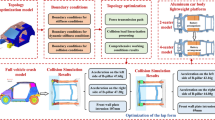Abstract
A version of an electric vehicle was developed and designed for the US market on the basis of the required domestic body structure. When compared with the original car, the new car body design leads to two major technical difficulties. First, the installation of high-voltage components such as the battery pack and other new energy sources increases the vehicle weight and occupies a great deal of its structural space; this limits the impact paths and the use of traditional structural designs, which greatly increases the design difficulty. Second, the USA, as an advanced automobile-using country, has well-developed laws and regulations for collision standards, vehicle operating conditions and evaluation standards. Using a combination of butterfly diagram analysis, bending moment management, section forces and other computer-aided simulation and analysis techniques, this paper presents a body structure design that can achieve a “GOOD” evaluation under the US Insurance Institute for Highway Safety (IIHS) side impact body structure conditions by optimizing the force transfer path, the B-pillar deformation mode and the threshold support structure. The threshold support structure supports realization of the “GOOD” rating for IIHS side impact and helps the body to meet the crash requirements of the Federal Motor Vehicle Safety Standard FMVSS214 and the US New Car Assessment Program (NCAP) requirements for side impact at 32 km/h and 75° angular pole impact.

























Similar content being viewed by others
Abbreviations
- IIHS:
-
Insurance institute for highway safety
- MDB:
-
Moving deformable barrier
- FMVSS:
-
Federal motor vehicle safety standards
- NCAP:
-
New Car Assessment Program
References
Liu, M.: Environmental problems in China—an overview. Chin. Bus. Rev. 5(1), 56–59 (2006)
Chris, L.: Electric car market statistics. Next Green Car https://www.nextgreencar.com/electric-cars/statistics/. Accessed 14 June 2018
Yuan, B.: Research of Chinese new energy vehicle industry development strategy and path. Rev. Ind. Econ. 5, 4 (2017). https://doi.org/10.14017/j.cnki.2095-5766.2017.0208
China Automotive Technology and Research Center: C-NCAP Management Regulation (2015 edn.) http://www.c-ncap.org/cms/files/cncap-regulation-2015.pdf. Accessed 1 June 2018
National Highway Traffic Safety Administration: United States Federal Motor Vehicle Standards and Regulations. https://www.safercar.gov. Accessed 9 June 2018
National Highway Traffic Safety Administration: Side Impact Protection. https://www.safercar.gov. Accessed 9 June 2018
Insurance Institute for Highway Safety: IIHS Side Impact Test Program Rating Guidelines (2006) https://www.iihs.org. Accessed 9 June 2018
Chou, C., Aekbote, K., Le, J.: A review of side impact component test methodologies. Int. J. Veh. Saf. 2(1/2), 141–184 (2007)
Hu, Y.M., Jiang, Y.Z., Yu, H., et al.: A study on the optimization and matching of subarea stiffness in the passenger compartment of a car for side impact. Automot. Eng. 36(8), 950–956 (2014)
Song, S.I., Park, G.J.: Multidisciplinary optimization of an automotive door with a tailored blank. Proc. Inst. Mech. Eng. Part D J. Autom. Eng. 20(2), 151–163 (2006)
Ma, C.S., Zhang, J.H., Huang, S.L.: Structural improvement for vehicle side impact based on the design of experiment mothodology. Automot. Eng. 36(2), 195–199 (2014)
Cui, A., Zhang, H., Yu, D.N., et al.: A study on material selection for multi-material autobody components based on PSI method. Automot. Eng. 40(2), 239–244 (2018)
Goede, M., Stehlin, M., Rafflenbeul, L., et al.: Super light car-lightweight construction thanks to a multi-material design and function integration. Eur. Transp. Res. Rev. 1(1), 5–10 (2009)
Li, Y.H., Lin, J.P.: Status-quo and trends of researches on tailor welded blanks for vehicle body. Automot. Eng. 36(6), 393–398 (2011)
Yang, K.H.: Application of CAE technology in the development of safer vehicles. Chin. J. Automot. Eng. 1(4), 393–398 (2011)
Author information
Authors and Affiliations
Corresponding author
Ethics declarations
Conflict of interest
The authors declare that they have no conflict of interest.
Rights and permissions
About this article
Cite this article
Liu, X., Liang, M. & Luo, Q. Innovative Electric Vehicle Body Design Based on Insurance Institute for Highway Safety Side Impact Conditions. Automot. Innov. 2, 201–211 (2019). https://doi.org/10.1007/s42154-019-00070-4
Received:
Accepted:
Published:
Issue Date:
DOI: https://doi.org/10.1007/s42154-019-00070-4




